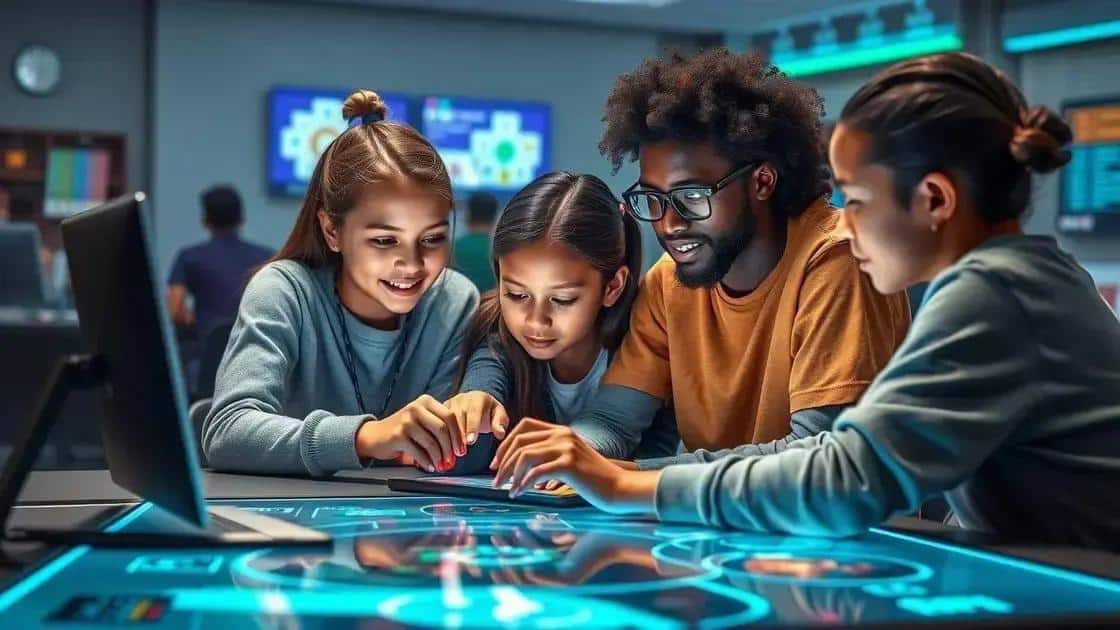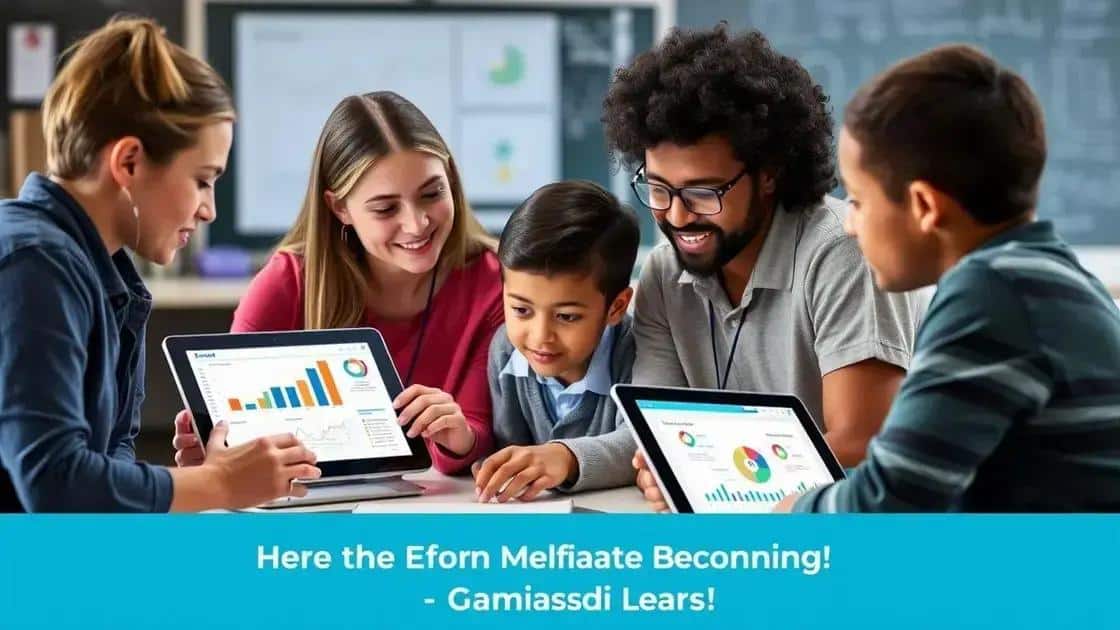Insights on gamified learning platforms: unlocking potential

Gamified learning platforms enhance student engagement and motivation by incorporating game elements like points and badges, while also improving retention and fostering collaboration among learners.
Strong data highlights how insights on gamified learning platforms can transform education. Have you ever thought about how these innovative approaches boost engagement and retention?
Understanding gamified learning environments
Understanding gamified learning environments is essential in today’s educational landscape. These platforms leverage game mechanics to engage and motivate learners in ways traditional methods often can’t.
What are gamified learning environments?
Gamified learning environments are systems that incorporate game elements into educational experiences. This approach aims to enhance student involvement and learning outcomes. By using points, levels, and badges, students feel a sense of achievement as they progress.
Benefits of gamified learning environments
There are several key benefits that gamified learning offers:
- Increased engagement: Students are more likely to participate actively when they enjoy the learning process.
- Enhanced motivation: Game-like elements can drive students to achieve goals and complete tasks.
- Improved retention: Interacting with content in a fun way often helps students remember information better.
Gamified learning platforms can also foster collaboration among students. Many platforms encourage teamwork through challenges and competitions. This not only builds social skills but can also lead to a deeper understanding of the material. As students work together to solve problems or achieve goals, they develop critical thinking and interpersonal skills.
Additionally, these environments often provide immediate feedback, which is vital for learning. Students can quickly know where they stand and what they need to improve. This instant gratification can lead to a growth mindset, where students are motivated to keep trying and learning.
Challenges in implementing gamified learning
While there are many benefits, there are also challenges. Designing a gamified learning environment requires careful planning. Here are a few challenges:
- Balancing fun and education: It’s crucial to ensure that the game elements do not overshadow the educational goals.
- Resource availability: Schools may lack the necessary technology to implement gamified systems.
- Resistance to change: Some educators may be hesitant to adopt new methods.
Despite these challenges, the potential for creating an engaging and dynamic classroom experience makes it worthwhile to explore gamified learning environments. As technology advances, we can expect to see these platforms become increasingly integral to education, creating opportunities for all students to thrive.
Key benefits of gamified platforms

Gamified platforms offer numerous advantages that can significantly enhance the educational experience. These benefits range from increased student engagement to improved learning outcomes.
Increased Engagement
One of the most notable benefits of gamified platforms is their ability to increase engagement. Students often find traditional educational methods less interesting. In contrast, gamified environments make learning fun and interactive. By incorporating elements such as points, badges, and leaderboards, platforms encourage students to actively participate.
Motivation and Goal Setting
Gamification motivates students to set and achieve goals. When students see tangible rewards for their efforts, it encourages them to keep trying. This motivation can lead to:
- A greater sense of achievement as students complete tasks.
- The desire to improve and compete, fostering a healthy competitive environment.
- Increased perseverance when faced with challenges.
Another key aspect is the element of storytelling used in many gamified platforms. By placing students in engaging narratives, they become more invested in their learning journeys. This narrative component helps students connect emotionally to the content.
Enhanced Retention of Information
Studies show that students retain information better when engaged in gamified experiences. When learners are actively involved, they develop a deeper understanding of the material. This process occurs as they navigate through scenarios that require critical thinking and problem-solving skills. As learners interact with content in these dynamic environments, they are more likely to remember key concepts.
Moreover, gamified platforms often provide immediate feedback. This instant response helps students recognize their strengths and areas for improvement. By receiving feedback instantly, students adjust their learning strategies more effectively.
Collaboration and Social Interaction
Another significant benefit is the emphasis on collaboration. Many gamified platforms include team-based activities, promoting social interaction among students. This collaboration fosters teamwork and communication skills.
- Students learn to support one another as they progress through challenges.
- They develop empathy and understanding by working in diverse groups.
- This interaction creates a community of learners, enhancing the overall educational experience.
In summary, the key benefits of gamified platforms lie in their capacity to create engaging, motivating, and interactive learning experiences. By leveraging these elements, educators can enhance student motivation and facilitate better learning outcomes, ultimately contributing to a more impactful educational environment.
Designing effective gamification strategies
Designing effective gamification strategies is crucial for maximizing the impact of educational platforms. These strategies engage students and enhance their learning experiences.
Understanding Your Audience
The first step in creating effective gamification is understanding your audience. Different age groups and learning styles require tailored approaches. Know what motivates your students, whether it’s competition, collaboration, or achieving personal goals.
Incorporating Game Elements
Effective strategies often include various game elements. Here are some key components to consider:
- Points: Reward students with points for completing tasks, encouraging them to take part in more activities.
- Badges: Use badges to recognize achievements, providing students with a sense of accomplishment.
- Levels: Create levels that students can advance through, keeping them engaged as they strive to improve.
- Leaderboards: Introduce leaderboards to foster healthy competition among peers.
These elements create a game-like atmosphere that encourages participation and engagement. However, balancing these features is essential to ensure that learning remains the primary focus.
Creating Meaningful Challenges
Challenges must be engaging but achievable. When designing tasks, make sure they align with learning objectives. Challenges should push students but not frustrate them. Varying the difficulty keeps learners interested and allows them to progress at their own pace.
Incorporating narratives or themes can enhance engagement. A well-constructed story can create emotional connections, making lessons more memorable. For instance, using a quest narrative can ignite students’ curiosity, motivating them to explore further.
Providing Feedback and Rewards
Timely feedback is essential in any gamification strategy. Providing students with insights into their performance helps them understand their progress. Positive reinforcement encourages continued effort, while constructive feedback directs their attention to areas for improvement.
Incorporating a reward system enhances motivation. Rewards can be tangible, like certificates, or digital, like unlocking new content or features. This recognition of effort solidifies a growth mindset in students.
Encouraging Collaboration
Collaboration among students is vital in gamified environments. Include team-based activities or challenges that require students to work together. This not only builds teamwork skills but also fosters a supportive learning community.
- Forming groups for quests can enhance social interaction.
- Facilitating peer-to-peer feedback helps students learn from one another.
- Creating opportunities for collaboration can lead to deeper understanding and retention of material.
In summary, designing effective gamification strategies involves understanding your audience, utilizing engaging game elements, and creating meaningful challenges. By implementing these strategies, educators can enhance student motivation and learning.
Evaluating the impact of gamified learning

Evaluating the impact of gamified learning is essential for understanding how these platforms contribute to educational success. Collecting data on student engagement and performance helps educators make informed decisions.
Measuring Engagement
One of the first aspects to evaluate is student engagement. Metrics such as login frequency, time spent on tasks, and participation in activities provide insights into how involved students are. When examining gamified platforms, consider exploring:
- The number of challenges completed by students.
- Participation rates in group activities versus individual tasks.
- Feedback from students about their level of enjoyment and interest.
These measurements help identify how effectively the gamification elements keep students motivated. A noticeable increase in engagement often indicates that the gamified aspects are successful.
Assessing Learning Outcomes
It’s vital to analyze how gamified learning influences academic performance. Consider comparing test scores, project grades, and overall completion rates before and after implementing gamified strategies.
Additionally, tracking improvements in knowledge retention is essential. Look for indicators like:
- Results from pre- and post-tests.
- Assessment scores on topics covered using gamified approaches.
- The ability of students to apply learned concepts in real-world scenarios.
When students show significant improvement, it demonstrates the effectiveness of gamified learning techniques.
Feedback from Educators and Students
Gathering qualitative data is also crucial for evaluating impact. Surveys and interviews with both students and educators can provide valuable insights. Ask questions about their experiences, such as:
- How do students feel about the gamified platform?
- What challenges do educators face when using gamification?
- What suggestions do participants have for improvement?
This feedback can highlight strengths and weaknesses in the gamified learning experience, guiding future adjustments and enhancements.
Long-Term Effects
Finally, consider the long-term effects of gamified learning on students. Analyzing retention rates and the continued application of skills learned will offer a broader view of the effectiveness of these strategies.
Monitoring students’ academic trajectories will provide insights into how well gamified experiences prepare them for future challenges, both academically and personally. By taking a holistic approach to evaluating gamified learning, educators can better understand its impact and refine their strategies for improved outcomes.
In conclusion, understanding and implementing gamified learning platforms can significantly enhance student engagement and educational outcomes. By incorporating game elements such as points, badges, and challenges, educators can create an interactive environment that motivates students. Evaluating the impact of these strategies through engagement metrics, academic performance, and qualitative feedback allows for continuous improvement. As educators seek innovative ways to inspire learners, gamification stands out as a powerful tool for fostering a richer learning experience.
FAQ – Frequently Asked Questions about Gamified Learning Platforms
What are gamified learning platforms?
Gamified learning platforms use game elements like points, badges, and challenges to enhance student engagement and motivation in educational settings.
How do I measure the effectiveness of gamified learning?
You can measure effectiveness by analyzing student engagement metrics, academic performance improvements, and gathering feedback from both students and teachers.
What are the main benefits of using gamification in education?
The main benefits include increased engagement, improved retention of information, enhanced motivation, and fostering collaboration among students.
What challenges might I face when implementing gamified learning?
Challenges can include balancing fun with educational goals, ensuring access to necessary technology, and overcoming resistance to change from educators and students.






